Is singing training beneficial to people with COPD?
A recent Danish randomized controlled trial suggests that singing training confers objective and subjective improvements within community-based pulmonary rehabilitation for people with Chronic Obstructive Pulmonary Disease (COPD).
Chronic Obstructive Pulmonary Disease (COPD) is a common disease characterized by chronic inflammation and airflow limitation, with predominant symptoms such as dyspnea, cough, and sputum. COPD is furthermore associated with impaired physical activity, social isolation, psychological distress, and impaired quality of life (QoL).1,2
Pulmonary rehabilitation (PR) is a key component in comprehensive COPD care to enhance physical capacity and QoL. PR is based on evidence-based activities1,2 among which Physical Exercise Training (PExT) is a gold standard activity. However, PR faces challenges such as the ability to perform PExT, high dropout rates, and lack of motivation and maintenance. Therefore, it has been requested to investigate alternative, evidence-based activities to supplement increasingly personalized PR.1,3
Recently, singing has become increasingly popular as a leisure time activity in COPD and may be relevant as a novel PR intervention, being both a physiologically oriented activity – e.g. focusing on respiratory muscles – and a social activity associated with joy and cohesion. However, the impact of singing on key outcomes in PR, such as walking distance, is still not known and high-quality, large-scale studies are requested.4-6
A Danish randomized controlled trial on singing in COPD
We conducted a multicentered, randomized controlled trial (RCT) comparing singing with conventional PExT within a 10-week community-based PR program, and the results were published in the European Respiratory Journal (2021).7
The trial was conducted between August 2017 and May 2019. In total, 270 COPD patients were included from eleven municipalities distributed across Denmark: Lolland, Vordingborg, Faxe, Slagelse, Rudersdal, Helsingør, Hedensted, Silkeborg, Ikast-Brande, Vesthimmerland og Lemvig.
The primary study endpoint was change in exercise capacity, measured by the Six-Minute Walking Test Distance (6MWD) with a minimal important difference (MID) of 30 metres. Further, we included selected secondary outcomes:
- Quality of life (St George’s Respiratory Questionnaire; MID -4 units)
- Lung function
- Dyspnea
- Anxiety
- Depression
- Adherence
We used the current best-practice and most well-described disease-specific methodological approach, Singing for Lung Health (SLH), developed in the UK5,6,8. This approach focuses on breathing, voice, and body, using exercises and songs as tools for the purpose and including movement/dancing during singing. There is, however, no common approach to singing in COPD in Denmark.9 Therefore, the singing leaders assigned for the RCT participated in a training workshop facilitated by the British team of experts within SLH prior to trial initiation.
Study participants were assigned to a PR programme with either SLH or PExT twice weekly at the local community PR service (healthcare centre). Both study groups furthermore participated in standard PR patient education, e.g. on lifestyle change and management of disease and everyday life.
The PExT intervention was delivered by locally-based physiotherapists and was based on the Danish national clinical PR guideline, with some tailoring to local preferences, and individual participant needs.3 Content and delivery of SLH and PExT are described in the Supplementary files of the RCT article (Supplementary Files; Appendices S2-S3).7
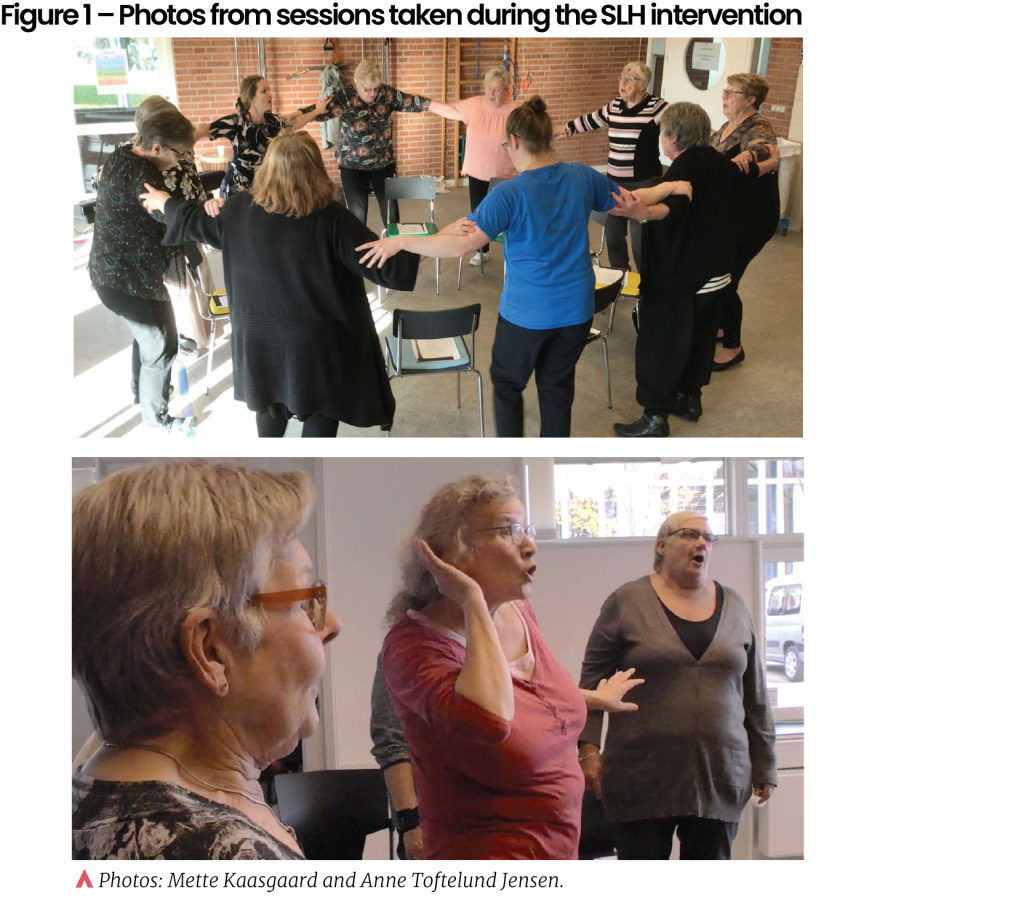
Singing for Lung Health was non-inferior to Physical Exercise Training
In total, 270 eligible COPD patients (SLH group: n=145; PExT group: n=125) were included in the study and 195 (SLH: n=108; PExT: n=87) completed both baseline and follow-up assessments.
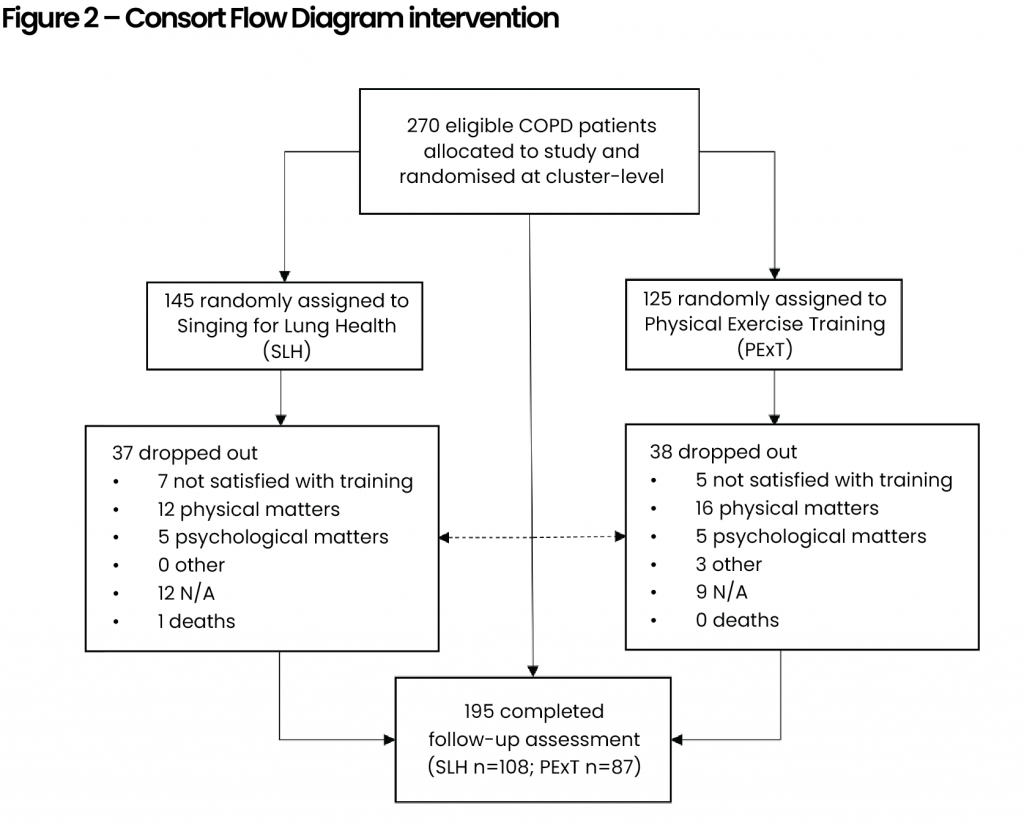
At baseline, the two study groups were comparable. Females accounted for 62.2%, mean age was 69.5 ±8.4 years, mean BMI 27.8 ± 6.0, mean pack years 40.5 ± 21.3, mean FEV1% predicted 51.4% ± 16.8%, and mean 6MWD 382.3 ± 102.4 metres.
SLH was non-inferior compared to PExT in improving 6MWD and in the proportion of participants achieving MID in 6MWD (30 m) (p=0.81 [95% CI: 7.28;9.30]). Besides, SLH was non-inferior regarding improvements in QoL (SGRQ). See Table 1 and Figure 3.
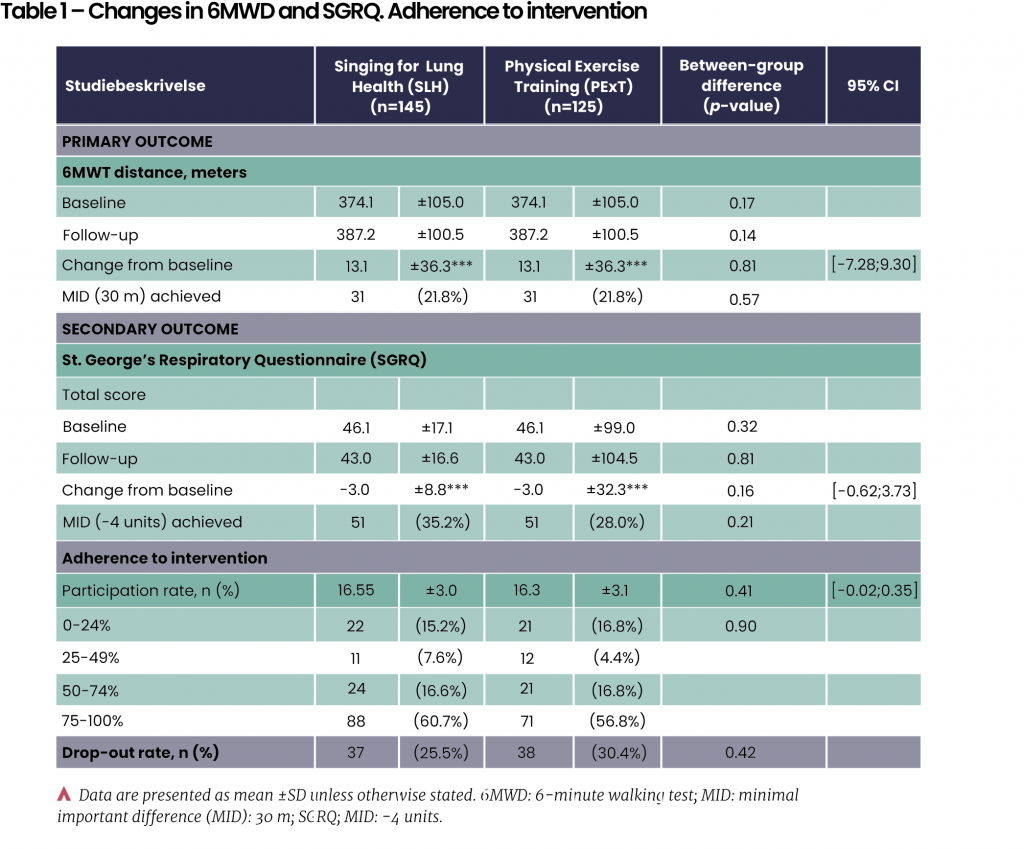
Non-inferiority related to 6MWD remained after adjustments for sex, age, BMI, GOLD class, and expectations towards benefits of singing. In both groups, adherence was correlated to chances of achieving MID in 6MWD.
We found no between-group differences regarding lung function, dyspnea, anxiety and depression, or adherence.
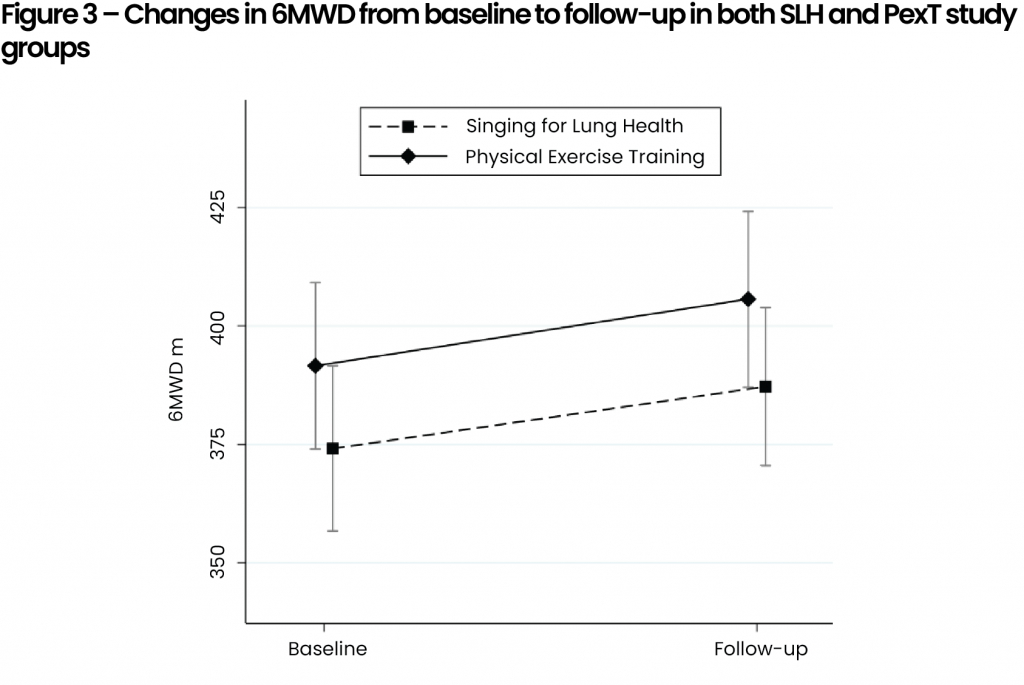
Singing for Lung Health was associated with physiological changes in COPD
Previous initial studies have indicated that singing improves lung function, besides hyperinflation and dyspnea. However, this has not yet been convincingly confirmed in clinical studies.
Therefore, we conducted posthoc analyses within the RCT data exploring physiological changes of SLH.10 Specifically, we used data from the per-protocol population in the SLH group (n=108), comparing the proportion who achieved MID with those who did not achieve MID, both within outcome 6MWD and within outcome QoL.
Our data suggest that improvements in 6MWD were associated with improvements in heart rate response, whereas improvements in QoL were associated with physiological changes in 6MWD, lung function, inspiratory function and control, and dyspnea.
Overall, a larger proportion achieved improvements in QoL (49%) than in 6MWD (29%). Interestingly, however, there was no significant overlap between achieving improvements in outcomes 6MWD and QoL.
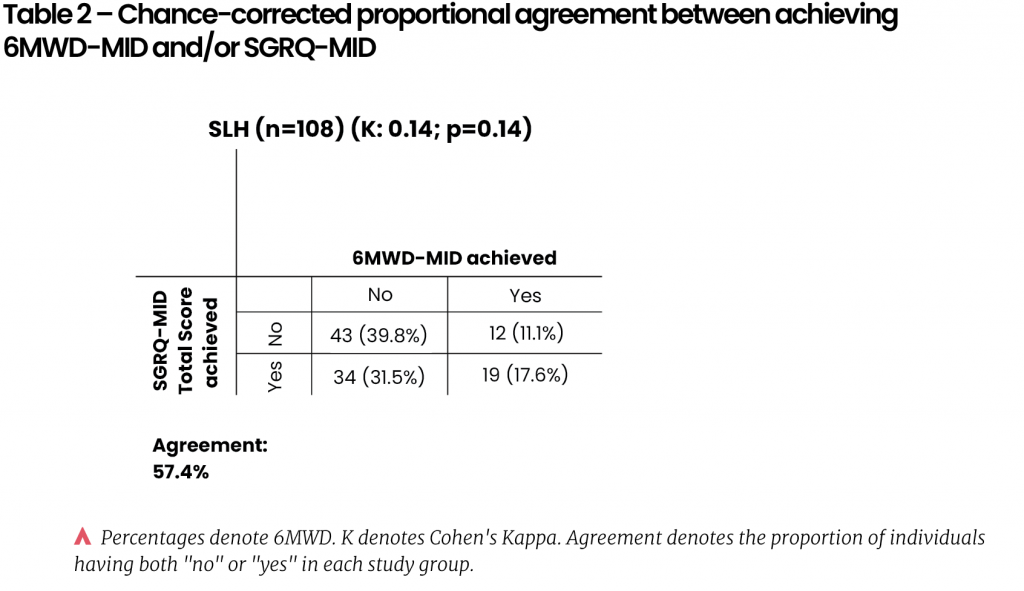
Supplementary analyses suggested that SLH was associated with more physiological changes and improvements in QoL than in the PExT group.
Our data suggest that overall improvements were associated with having a more challenging starting point regarding walking distance, BMI, lung function, and dyspnea. Obviously, it is likely easier to improve from a more challenging starting point, but it is possible that singing/SLH generally may be an easier activity to start with and maintain if PExT appears too challenging. Further studies are needed to elucidate these aspects.
Conclusion
Singing appears to be relevant and beneficial in COPD in both objective and subjective parameters and represents more than a pleasant leisure time activity. Delivered as a structured, health-promoting activity, singing (SLH) may be relevant to include as part of a diverse, personalized offer within future pulmonary rehabilitation. However, there is a need for use and implementation of a standardized, disease-specific, homogenous framework for singing in COPD.
Further studies are needed to replicate our study, to assess long-term effects and maintenance, to explore mechanisms and phenotypes, and to evaluate health-economic aspects.
-
References
. Vogelmeier, C., et al. Global Initiative for Chronic Obstructive Lung Disease (GOLD). Global Strategy for the Diagnosis, Management and Prevention of COPD Report. 2022. [Internet]. 2022. Available from: https://goldcopd.org/2022-gold-reports-2/.
- Gibson GJ, Loddenkemper R, Sibille Y, Society ER, Lundbäck B. The European Lung White Book: Respiratory Health and Disease in Europe [Internet]. European Respiratory Society; 2013. Available from: https://books.google.dk/books?id=-C_fnQEACAAJ.
- Danish Health Authority. National Clinical Practice Guideline on Rehabilitation for Chronic Obstructive Pulmonary Disease [Danish]. Electronic ISBN: 978-87-7104-030-2 Published June 3, 2014. 2014.
- McNamara RJ, Epsley C, Coren E, McKeough ZJ. Singing for adults with chronic obstructive pulmonary disease. Cochrane Airways Group, editor. Cochrane Database of Systematic Reviews [Internet] 2017 [cited 2021 Mar 13]; Available from: http://doi.wiley.com/10.1002/14651858. CD012296.pub2.
- Lewis A, Cave P, Stern M, Welch L, Taylor K, Russell J, Doyle A-M, Russell A-M, McKee H, Clift S, Bott J, Hopkinson NS. Singing for Lung Health—a systematic review of the literature and consensus statement. npj Prim Care Resp Med 2016; 26: 16080.
- Heydon R, Fancourt D, Cohen AJ. Heydon, R., Fancourt, D., & J. Cohen, A. The Routledge Companion to Interdisciplinary Studies in Singing (1st ed.). 2020. Volume III: Wellbeing. PART I Singing and Health. Chapter 7, pp. 86-97. Routledge.” https://doi.org/10.4324/9781315162546. Routledge; 2020.
- Kaasgaard M, Rasmussen DB, Andreasson KH, Hilberg O, Løkke A, Vuust P, Bodtger U. Use of Singing for Lung Health as an alternative training modality within pulmonary rehabilitation for COPD: an RCT. Eur Respir J 2021: 2101142.
- Lewis A, Cave P, Hopkinson NS. Singing for Lung Health: a qualitative assessment of a British Lung Foundation programme for group leaders. BMJ Open Resp Res 2017; 4: e000216.
- Kaasgaard M, Andersen IC, Rasmussen DB, Hilberg O, Løkke A, Vuust P, Bodtger U. Heterogeneity in Danish lung choirs and their singing leaders: delivery, approach, and experiences: a survey-based study. BMJ Open 2020; 10: e041700.
- Kaasgaard M, Rasmussen DB, Løkke A, Vuust P, Hilberg O, Bodtger U. Physiological changes related to 10 weeks of singing for lung health in patients with COPD. BMJ Open Resp Res 2022; 9: e001206.
-
Conflict of interest
No conflict of interest to declare.
Brænder du for at skrive?
Vil du gerne dele din forskning eller dine kliniske erfaringer med dine kollegaer inden for netop dit speciale? Har du en ide til en artikel, som du gerne vil udgive hos os? Send redaktionen en mail på redaktion@bpno.dk
Send mail til redaktionen










